So there were many ways, this Moderate believes, that Harris could have campaigned more effectively on several key issues.
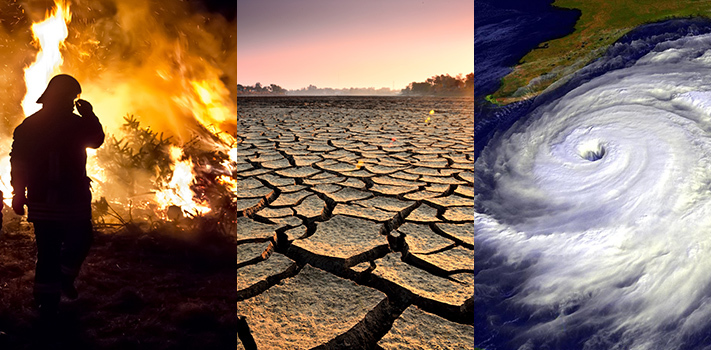
Climate Change Visionaries
Editor’s Note: Respect for science is one of TMM’s Basic Beliefs. Moderates, and all other humans, owe the climate-science pioneers described in this Guest Blog a debt of gratitude – along with citizen-scientists, activists and educators like George S. Turner (author of the blog), who continue studying climate change and informing all of us about it. Without them, our collective knowledge of climate change would have evolved much later – meaning it would have taken us even longer to understand (and eventually, reach consensus) that it is real, accelerating – and dangerous.
Earth’s current geological age (the Anthropocene) is viewed as the period during which human activity has been the dominant influence on climate and the environment. Our understanding of this period relies on those who discovered the physics and chemistry underlying global warming, popularly known as Climate Change:
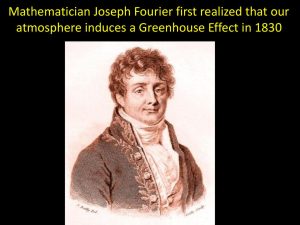
- Joseph Fourier (1768 – 1830), French mathematician and physicist, predicted the Earth’s atmosphere might act as a thermal insulator – widely recognized as the first proposition of what is now known as the greenhouse effect. [1]
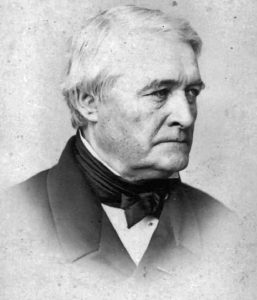
- Claude Pouillet (1790 – 1868) further developed Fourier’s work on the surface temperature of the earth, the first mathematical treatment of the greenhouse effect. He speculated water vapor and carbon dioxide might trap “heat (infrared) radiation” in the atmosphere, warming the earth enough to support plant and animal life. [2]
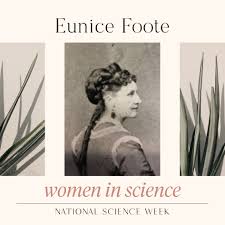
- Eunice Newton Foote (1819-1888) was the first scientist known to have experimented on the warming effect of sunlight on different gases. She later theorized, in 1856, that changing the proportion of carbon dioxide in the atmosphere would change its temperature. [3]
A pioneering feminist as well as scientist, Foote attended the 1848 Seneca Falls Convention, the first women’s rights convention.
Foote allowed ordinary sunlight to irradiate glass tubes, each containing atmospheric gases (carbon dioxide, water vapor, hydrogen) under variable pressures. These tubes also contained calibrated mercury thermometers for the direct observation of equilibrium temperatures. She found tubes containing carbon dioxide rose to the highest temperatures, “…and were, by far, the slowest to cool down after removal from sunlight”. She surmised “an atmosphere of that gas would give our earth a high temperature; and if, at one period of its history, the air had mixed with it a larger proportion than at present, an increased temperature from its own action, as well as from increased weight, must have necessarily resulted.”
Foote’s findings were presented in 1856 – making her the first scientist to experimentally confirm carbon dioxide is a key atmospheric greenhouse gas. [3]
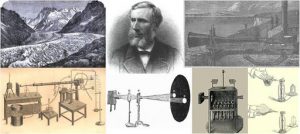
- John Tyndall (1820 – 1893), Irish physicist and chemist, analyzed infrared (radiant heat) absorption spectroscopy of atmospheric gases, including carbon dioxide, ozone, methane, and other trace gases, as well as water vapor.
Tyndall correctly concluded water vapor is the strongest absorber and incorrectly concluded it controls air temperature. Water vapor is the strongest absorber in that range of conditions where humidity is high, but CO2 concentration is largely independent of temperature – and therefore the controlling factor in global warming.
Tyndall in 1860 was the first to demonstrate that visually transparent gases, such as oxygen and nitrogen, are infrared emitters.
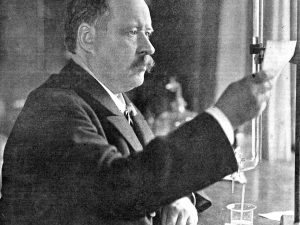
- Svante Arrhenius (1859 – 1927), Swedish physicist and a founder of physical chemistry, received the Nobel Prize for Chemistry in 1903.
Arrhenius was the first to use physical chemistry principles to estimate the earth’s surface temperature. He also studied geology (especially ice ages’ origins), astronomy, physical cosmology, and astrophysics.
In 1896, developing a hypothesis to explain ice ages, Arrhenius used physical chemistry to estimate the extent to which growth in atmospheric carbon dioxide (CO2) concentration increases Earth’s surface temperatures through the greenhouse effect. He concluded human-caused CO2 emissions, from fossil-fuel burning and other combustion processes, are significant enough to cause global warming. This conclusion has been extensively tested, confirming Arrhenius as a climate-science trailblazer.
Arrhenius suggested human-caused CO2 emissions could prevent a new ice age, and humans needed a warmer earth to feed its rapidly-increasing population. [5] [As sage as Arrhenius was, he probably never imagined the concentration of CO2 in the atmosphere would increase 40% in the following 120 years.]
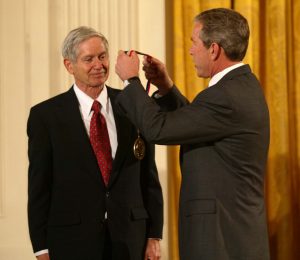
- American scientist Charles David Keeling (1928 – 2005) confirmed Arrhenius’ 1896 proposition regarding anthropogenic contribution to the “greenhouse effect” and global warming. He documented steadily-rising carbon dioxide levels, and his Keeling Curve measures progressive buildup of CO2 (a greenhouse gas) in the atmosphere.
Keeling developed the first instrument able to measure CO2 concentration in atmospheric samples reliably and accurately. Camping at Big Sur, California, Keeling used his new device to measure CO2 levels, finding they had risen since the end of the 19th century.
Later, at Scripps Institution of Oceanography, Keeling obtained funding to establish the base on Mauna Loa, Hawaii, collecting CO2 samples there beginning in 1958. By 1960, he documented strong seasonal variations in carbon dioxide, with peak levels in the late northern-hemisphere winter. A reduction in CO2 followed during spring and early summer each year, as plant growth increased in the land-rich northern hemisphere. In 1961, his data showed CO2 levels were rising steadily in what later became known as the “Keeling Curve”, a graph of CO2 mean concentration in parts per million versus time in years [6]:
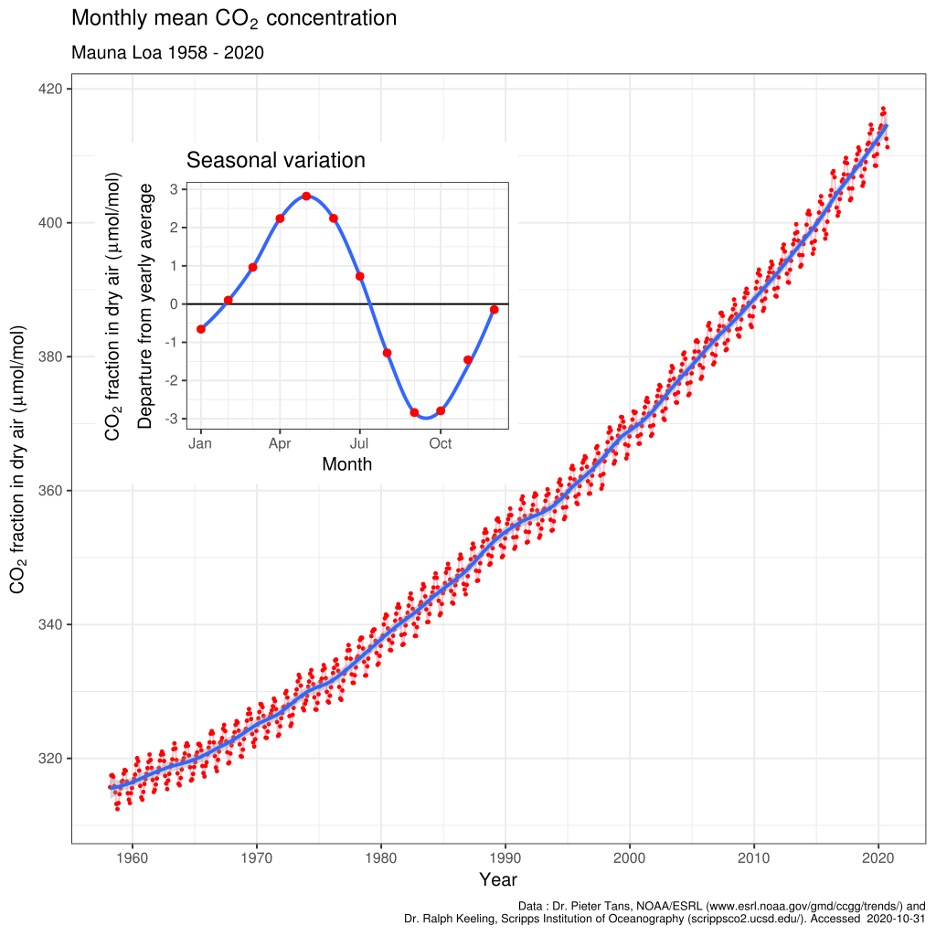
(The inset shows an example of seasonal variation within one arbitrary year.)
Note the Keeling Curve illustrates the exponential nature of the growth of CO2 concentration, which has risen rapidly since the beginning of the 21st century. [6]
About the Author: George S. Turner earned a BS in Chemistry, BA, from North Texas University, with advanced studies in Physical Chemistry at Georgia Institute of Technology. A businessman as well as scientist, he is the retired Founder of DiversiTech Corporation in Duluth, GA, and retired Co-Founder of Architectural Brass Company in Atlanta, GA. Not one to rest on his laurels, his retirement interests include political and environmental activism.
Bibliography
[1] Refer to Wiki. Refs. under Joseph Fourier [2] Refer to Wiki. Refs. under Claude Pouillet [3] Refer to Wiki. Refs. under Eunice Newton Foote [4] Refer to Wiki. Refs. under John Tyndall [5] Refer to Wiki. Refs. under Svante Arrhenius [6] Refer to Wiki. Refs. under Charles David Keeling
Images: Google Images
Fire, drought, hurricane: NASA Climate Change
Fourier: SlidePlayer
Pouillet: Wikipedia
Foote: Facebook
Tyndall: infocobuild
Arrhenius: ThoughtCo
Keeling, Bush: Wikimedia Commons
Community Guidelines
The Modern Moderate welcomes readers’ ideas and discussions of issues. We do insist, in Moderate fashion, that comments should be as respectful and informed as possible, to keep our site constructive for our readers. Therefore, posts deemed hostile, obscene, untrue, or misleading will be deleted, and authors of those comments may be blocked from posting comments in the future. Thank you for your cooperation.




Admiring the commitment you put into your website and detailed information you present.
It’s good to come across a blog every once in awhile that isn’t the same old rehashed information. Wonderful read!
I’ve bookmarked your site and I’m including your RSS feeds to my Google account.